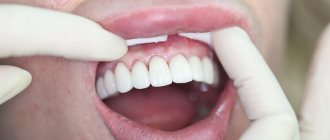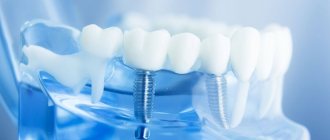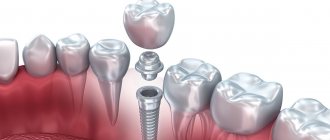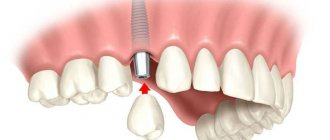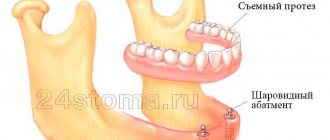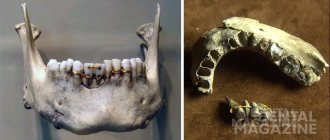The opinion that “implantation is painful” exists among those people who have not yet had such an operation. The fear has its roots in the Soviet past, when treatment and many procedures were indeed painful and were carried out without anesthesia. This approach has not been used for a long time. Modern high-quality dentistry offers treatment without pain; for this, specialists have a whole range of special methods and means. Therefore, there is no need to be afraid of implantation. This operation brings even less discomfort than tooth extraction or pulpitis treatment.
Dental implantation - does it hurt?
Is it painful or not to insert a dental implant? Many patients are interested. The answer is no, since the operation is performed under anesthesia. Types of anesthesia used in dentistry:
- Local - an injection is given, after which the sensitivity of the area disappears for the duration of the operation. The gums are “frozen”, and the bone tissues are not susceptible to pain.
- Anxiolysis is minimal sedation with a calming effect, the patient ceases to be afraid of the procedure.
- Moderate sedation - the patient is completely relaxed, but still conscious.
- Oversedation is a state of half-asleep.
- General anesthesia is rarely used. Indications: gag reflex, allergies to local anesthesia, mental disorders. Performed during extensive operations - bone grafting, installation of more than 10 implants.
In our Center, we offer the patient light sedation; the patient in this state does not feel pain, does not worry, and calmly responds to the doctor’s requests.
Does it hurt to get dental implants?
Contrary to popular belief, dental implants do not hurt. The fact is that this procedure is carried out using modern local anesthetics, and for the most sensitive patients the use of sedatives and even general anesthesia is provided:
- Local anesthesia
. The easiest way to eliminate painful sensations. During the implantation process, the drugs ultracaine, articaine or mepivacaine are used - they perfectly block nerve endings, and the analgesic effect can last for 2 hours after the procedure. Anesthetic injections are made directly into the operated area (infiltration and conduction anesthesia) or into the base of the skull to block the trigeminal nerve (trunk anesthesia). If the drug is selected correctly and the required dose, the patient does not experience pain, but feels all the manipulations performed by the doctor. It is for this reason that local anesthesia when installing implants is supplemented by the use of sedatives for patients who are particularly sensitive and fearful of dental intervention. - Minimal (superficial) sedation (anxiolysis)
. It is used in patients who experience anxiety during complex dental procedures - as a result, anxiety and fear go away, the patient is conscious (a feeling of slight drowsiness is possible), and follows all the doctor’s commands. - Moderate sedation
. If the patient is afraid of any medical intervention, it is possible to use moderate sedation - in this case, a little more sedative is used, as a result of which the patient remains conscious, can respond to the doctor’s commands, but is half asleep. - Oversedation
. It is also called deep sedation - increasing the dose of sedative puts the patient to sleep, while there is a reaction (sometimes with a slight delay) to a loud call or other external stimuli. In this state, the patient does not feel anything (provided that a local anesthetic is used), and he has virtually no memories of the installation of dental implants. Awakening occurs within 15 minutes after stopping the supply of the sedative drug (can be performed either intravenously or inhalation, using a mask). - General anesthesia
. This anesthesia technique is used in patients with allergies to any types of local anesthetics, with an increased gag reflex, in people who experience panic fear of dental treatment (dental phobia), in children. In addition, the dentist will recommend general anesthesia if during the operation it is planned to install more than 6-10 dental implants in combination with bone grafting. Consciousness is completely switched off, there is no reaction to any external stimuli, pain is not felt, any muscle activity is excluded, respiratory function is maintained using a ventilator. The use of general anesthesia requires the presence of an experienced anesthesiologist during dental implantation. Awakening occurs 20 minutes after the administration of the anesthetic, but it is advisable to remain under medical supervision for at least 40 minutes.
Sedative effect - reduction of irritability, relief from feelings of excitement or fear due to the use of special drugs - psycholeptics. Sedatives are not anesthetics, so during the installation of dental implants they are used exclusively in combination with local anesthetics.
The patient's condition under deep sedation and general anesthesia is similar. The only difference is that oversedation does not imply an anesthetic effect - pain sensations persist, and the patient remembers them, which can cause panic fear of dental treatment in the future.
In the process of choosing a specific type of anesthesia, the doctor is guided by the following factors:
- Patient's pain threshold (people with a low pain threshold most often require deep sedation or general anesthesia).
- Experienced fear or anxiety during dental operations.
- The presence of allergic reactions to certain types of anesthetics and sedatives.
- Vomiting reflex. In many patients, it manifests itself while dental instruments are in the oral cavity. A strong gag reflex can become a serious obstacle to the quality work of a doctor.
- The complexity of the upcoming operation.
The answer to the question of whether it is painful to place a dental implant directly depends on the correctly selected type of anesthesia - if suitable drugs were used during the operation, the patient will not experience any discomfort.
Before the procedure, the doctor conducts a thorough examination of the oral cavity, studies the patient’s medical history and X-rays, based on which he draws up a preliminary operation plan (single-stage, one-stage, two-stage) and selects the appropriate method of pain relief.
Reviews about dental implantation
Innocent
“At the beginning, I doubted for a long time whether I should undergo implantation. But still, one fine day I went and did it. You know, I didn't regret it. Yes, it was unpleasant in places and there were these restrictions, but the result outweighs all the disadvantages.”
Lena
“A couple of days ago my teeth were restored and 2 implants were inserted. I couldn't be happier with them! I finally have a full smile! One thing that was upsetting at first was the pain during and after the operation, and also the fact that I had a swollen cheek for two days.”
Svetlana
“I’ll tell you straight, it was scary. Before the operation itself, I was tormented by questions: will it hurt me, how much will it hurt, will there be any problems when they install new teeth for me, is this dental implant reliable, will it not fall out, what if I look worse with it, etc. In the end, I didn’t remember the procedure itself - they gave me an injection, fell asleep, and woke up with new teeth, like in a fairy tale. I was happy. The doctor said something and prescribed it, but I had no time for it. Then I realized that I should have listened, but it worked out too - I got sick for a couple of days and stopped. Yes, and for the sake of such beauty one can endure”
How to install implants
Anesthesia is performed only during surgical interventions. Prosthetics is a painless procedure. The implantation process consists of several stages:
First surgical – implant installation
The procedure begins with anesthesia. The patient is injected with an anesthetic into the area where the artificial root is installed. If the operation is performed under sedation, the anesthesiologist will first administer a sedative intravenously. The gum is peeled off, and a bed for an artificial root is created in the bone using special instruments. The implant is inserted into the prepared hole, a plug is fixed on top, and the tissue is sutured. The operation lasts 15-30 minutes. The anesthesiologist brings the patient out of a half-asleep state, after 20-30 minutes the patient can move independently, even drive a car. The next appointment is scheduled in 10 days to remove the stitches. The implant takes 2-4 months to take root in the lower jaw and up to six months in the upper jaw.
The second surgical stage is the installation of a gum former
After engraftment with the jaw bone, the implant is opened, the plug is removed, and a former is inserted. The procedure is performed under local anesthesia and lasts no more than 10 minutes. The former is installed for 10-14 days to create an even gingival contour.
Prosthetics
This stage is completely painless, because... no tissue incisions are required. The former is replaced by an abutment that connects the implant and the prosthesis. A crown is installed on it, made from previously taken impressions.
Complication after surgery
Even the most experienced dentist cannot guarantee you a complete absence of complications after dental implant surgery.
We will talk about the most common of them, and also give some tips for their treatment.
Pain
Pain after the anesthetic wears off is absolutely normal. Violation of the integrity of the gum tissue simply cannot be completely painless, and discomfort for 2-3 days after surgery is quite acceptable.
Depending on the patient's pain threshold, these sensations can range from slightly unpleasant to very strong. It is best to discuss pain relief options with your doctor (anti-inflammatory powders such as Nimessil, painkillers Aertal, Ketanov, etc.), and if you have unbearable pain, you must definitely go to the clinic - there may be severe inflammation, serious swelling or damage to the nerves. endings.
Swelling and inflammation
After a foreign body (dental implant) is implanted into the bone tissue, the body regards it as a danger and provides protection by accumulating fluid in adjacent tissues - this is how swelling is formed. This process begins within a few hours after surgery and lasts 5-7 days.
To relieve swelling from the gums (and sometimes the cheek also swells), it is recommended to apply ice. If the swelling does not go away for more than a week, the pain does not subside, blue discoloration or suppuration is observed in the area where the implant was implanted, the body temperature remains at 37-38 for more than a week, an inflammatory process may be occurring. It can also occur as a result of poor oral hygiene. If it is not corrected in time, the implanted tooth may be completely rejected by the body.
Bleeding
The place where the implant was screwed in may bleed for several days - during the deformation of the gum tissue, the blood vessels are inevitably damaged. It is important to correctly assess the strength of the bleeding - if it does not stop for more than a week, while the spotting is constantly increasing, hematomas form around the operated area, we can talk about serious damage to the capillary network.
For patients with poor blood clotting, the doctor will recommend hemostatic drugs.
Seam divergence
During the process of dental implantation, suturing is almost inevitable - it is performed after bone grafting, after screwing in the implant, after installing the gum former. Since it is impossible to ensure complete isolation of the operated area (the patient needs to eat, drink, talk, and perform daily hygienic procedures), it is important to carefully monitor the condition of the sutures: if they become separated, you should immediately consult a doctor - there may be mechanical damage (in this case In this case, the dentist will repair the sutures) or the inflammatory process (serious treatment may be required).
Temperature increase
Within 2-3 days after dental implantation, body temperature can remain at 37-37.5 degrees. If the thermometer shows 38 or higher for 4 or more days, the gums at the site where the pin is implanted fester, there is severe swelling and unbearable pain - this is already a cause for concern. In this case, we can talk about inflammation and the risk of subsequent implant rejection. Immediately go to the clinic - the dentist will take all necessary measures to eliminate the resulting pathology.
Numbness
Complete loss of sensitivity can be observed within several hours after implantation of a dental implant - this is due to the action of the anesthetic. In addition, in case of severe swelling, the fluid accumulated in the implant area puts pressure on the nerve endings, causing long-term numbness, which disappears after the swelling subsides.
Often there is damage to the neurovascular bundle (located in the lower jaw) during surgery - in this case, sensitivity will not return soon.
Implant rejection
This complication is quite rare - according to statistics, only 1% of all installed implants are rejected.
Reasons for rejection:
- Infection (untreated oral diseases, poor hygiene);
- Bone deficiency;
- Smoking immediately after the implantation procedure;
- Allergy to titanium;
- Carrying out implantation during periods of exacerbation of chronic diseases.
It is not difficult to detect implant rejection - the pin is mobile, there is severe pain and suppuration. If the diagnosis is confirmed, the dentist removes the pin, performs an antiseptic treatment and prescribes a complex of vitamins and minerals to restore the gums. Re-screwing the implant is possible after 1-3 months (depending on the condition of the patient’s tissues).
If any complications arise, you should not self-medicate or follow the advice of traditional medicine: you must immediately consult a doctor - timely medical assistance will help avoid serious problems such as inflammation and implant rejection.
The doctor’s opinion is that the operation itself is completely painless
Before installing a dental implant, patients often worry about the procedure and how they feel in the dentist’s chair. But there is no discomfort at all; the patient can only feel slight pressure or vibration. If we compare the procedure with tooth extraction, the latter feels much more unpleasant. For anxious patients, you can take a course of premedication before surgery.
Levin Dmitry Valerievich
Chief physician, Ph.D.
What to do if the addiction is seriously delayed?
If, over a fairly long period of time, you cannot get used to the prosthesis (that is, to a foreign body in the mouth), then there may be several logical explanations for this problem:
- Jaw atrophy;
- Individual characteristics of the jaw structure of a particular patient;
- Poor fixation of the structure;
The most difficult thing to get used to is the so-called clasp structures, which are based on fastenings made of metal. In addition to mechanical effects, exposed metal parts can also have chemical effects, reacting with the acidic environment of the oral cavity. It is simply impossible to correct such a product on your own, as it is easily damaged. Therefore, if you have the feeling that such a design is rather poorly and unreliably fixed in your mouth, it is better to go to a specialist. If the mobility of the prosthesis inside the oral cavity is due to jaw atrophy, a special ointment for additional fixation can help you.
How long does pain last after implantation?
Getting a dental implant does not hurt. But after the end of the anesthesia, discomfort will be felt; this is a normal reaction to the intervention. On average, it lasts 1-3 days, the intensity and duration depends on the volume of the operation and the number of artificial roots installed. The nature of the pain can be sharp, diffuse, shooting, pressing, aching or cutting. Other body reactions are within normal limits:
- itching;
- edema;
- compression of tissues and muscles.
How to make the rehabilitation period easier
First of all, it is important to strictly follow the doctor’s recommendations. Do not put stress on the area where the operation was performed or consume irritating foods or drinks. You should also give up alcohol and smoking, and not play sports. Swelling is a common consequence of root grafting surgery. This is a normal reaction of the body. The main thing is to ensure that all negative feelings gradually subside. If the swelling does not go away or gets worse, pain or redness appears, this is a reason to visit a doctor as soon as possible.
What to do to reduce pain
Unpleasant sensations come only after the anesthetic wears off. To reduce them it is recommended:
- take medications against pain, swelling, inflammation;
- avoid physical activity;
- do not touch the wound with your tongue or other objects;
- avoid hot baths, steam baths, saunas;
- do not drink alcohol, limit smoking.
We give out the necessary medications after the operation in a special package; you do not have to buy anything at the pharmacy. Rules for taking medications and other recommendations are indicated in the Patient Instruction.
Recommendations after surgery
Most often, implant rejection occurs due to the patient’s fault (failure to follow the dentist’s recommendations, failure to go to the clinic in a timely manner in case of complications, self-medication).
In order for the implant to take root, you need to follow a number of simple recommendations:
- Do not eat for 2 hours;
- During the entire healing period, do not eat spicy or too hard foods, avoid cold or hot foods;
- You can only chew on the side of the jaw opposite the sutures (to avoid their divergence);
- Take anti-inflammatory and painkillers recommended by your doctor, do antiseptic baths and rinses.
- Daily regular oral hygiene (brushing and paste, rinsing, flossing, etc.);
- If swelling occurs, apply ice to the cheek;
- Avoid any types of serious physical activity, avoid overwork;
- Smoking and drinking alcohol are ideally allowed only 1-2 weeks after surgery;
- Avoid active articulation, sneeze and cough very carefully;
- Add as many vitamins, minerals and nutrients to your diet as possible.
If these simple recommendations are followed, implant rejection, as well as the occurrence of any other serious complications, are excluded.
To avoid problems during implantation surgery, as well as in the postoperative period, you should give preference to trusted clinics and experienced, highly qualified specialists.
How long does it take for a wound to heal?
After surgery, the wound remains sensitive for 1-3 days. She needs special care for the next 2-3 weeks:
- upon returning home, apply ice or a cold compress to the intervention area;
- During the first hours you should not lie down, otherwise swelling may occur; it is better to sit or take a walk;
- You can only drink water at room temperature;
- Before the stitches are removed, you cannot eat flour, sticky foods, sweets, yoghurts; light soups, purees, and soft cutlets are allowed;
- in the first days, strong tea, coffee, and highly carbonated drinks are prohibited;
- You can chew only with the healthy side, rinse your mouth with warm water after each meal;
- one day after the operation, you can brush the adjacent teeth with a soft brush, but not with an electric brush or an irrigator.
Indications and contraindications for implantation
You can resort to implantation in case of partial or complete loss of teeth. This operation helps restore the dentition after the loss of one or more teeth, and also solves the problem of edentia.
However, the use of implantation methods is not always possible - the procedure has a number of contraindications:
Absolute
- Severe diseases of the cardiovascular, nervous, endocrine, respiratory systems (diabetes mellitus, osteoporosis, tuberculosis, oncology, poor blood clotting, mental disorders, etc.).
- Recent chemotherapy or organ transplantation – during this period there is a disruption in the body’s restorative functions, which can lead to rapid implant rejection.
- Allergy to any type of anesthetic - the operation itself is very painful and cannot be performed without pain relief.
- Pregnancy and breastfeeding.
Relative
- Any diseases of the oral cavity (they must be eliminated before installing implants);
- Insufficient hygiene (before installing implants, it is necessary to remove tartar and plaque);
- Malocclusion (corrected with braces);
- Bone atrophy (corrected through bone grafting);
- Vitamin deficiency, exhaustion of the body, stress (implantation is acceptable after complete recovery);
- Smoking more than 1 pack of cigarettes per day - after surgery this leads to implant rejection (before implantation it is necessary to get rid of the bad habit or reduce the number of “consumed” cigarettes as much as possible);
The dentist will also recommend avoiding extreme and traumatic sports to reduce the risk of mechanical damage to the implant.
As for age restrictions, there are none (with the exception, of course, of childhood and adolescence) - the possibility of implantation is determined not by the biological age of the patient, but by his general condition (often older people tolerate the procedure much easier than younger patients).
In any case, the possibility of performing an implantation operation is determined by the doctor.
If the pain in the implant area does not go away for a long time
Pain may be felt for up to 1-3 days, after which it is considered a deviation. Long-term discomfort is caused by impaired healing and microbial contamination. Signs of complications that do not stop for more than three days and are progressive:
- edema;
- bloody issues;
- strong pain;
- bad feeling;
- elevated temperature.
You cannot take anything on your own; you need to contact the doctor who performed the operation for help.
We want to reassure patients who are afraid to undergo implantation - this is a painless operation with a predictable successful result. Complex tooth extraction can be much more traumatic. If you follow the doctor's recommendations, there are no consequences. Even if all stages were successful, we schedule preventive examinations 2 times a year. This will help identify possible problems at an early stage and avoid complications.
Can implantation be dangerous to health?
Dental implantation is an absolutely safe procedure, much more atraumatic than wisdom tooth removal. By the way, the latter is much more serious than installing an implant in terms of complexity, number of complications and the difficulty of eliminating them. As with any other operation, various complications may arise after dental implantation, but all of them are compatible with life. The most unpleasant thing that can happen is, of course, implant rejection. Returning to the problem of pain associated with implantation, artificial dental roots are rejected almost imperceptibly for their owner - without pain or discomfort. However, if you seek help from a reputable dentist, the risk of such a complication or any other problem is reduced to zero.
If your doctor suggests you have a dental implant procedure and you're starting to wonder if it will hurt, don't be afraid to ask the doctor to talk about how the procedure will go. Understanding what you will be doing will help you get rid of groundless fears and overcome feelings of fear. Choose a specialist you can trust and a clinic where you will feel comfortable. With a professional approach to the patient from dental staff, fear and anxiety disappear completely in 100% of cases.
"All-on-4"
Obviously, those who have no teeth left in their jaws experience the greatest fear of pain from implantation. However, these worries are completely unfounded. For this case, a convenient and popular “All-on-4” technique is provided, which turns a completely bare jaw into a sparkling set of teeth. The essence of the method is to install only 4 implants on the upper or lower jaw (or 8 units if the patient has complete edentia in both jaws). A common prosthesis of 10 artificial teeth is immediately fixed onto the tops of the installed implants.
The dentist will advise which dental implants are best for each specific case. However, the patient should not be concerned about the pain of the procedure. It is much more important to choose a clinic and a specialist who will do everything correctly so that the result pleases both the aesthetic and functional side.
Author:
Mayorov Andrey Mikhailovich
Specialization:
orthopedic dentistry, dental prosthetics, implant installation
Which implant is better to place on chewing teeth?
Which implant should be placed on a chewing tooth to get a reliable and durable implantation result? Again, only a specialist can give you specific recommendations on this issue, after examination and comprehensive diagnostic studies. We can tell you that for installing implants in the area of chewing teeth, structures with the highest possible strength values are used. Only such implants will be able to withstand the constant high load exerted on the chewing teeth when biting and chewing food.
If you choose the wrong implant for installing and restoring the chewing elements of the dentition, the artificial root may not withstand the load and break, and then it will have to be removed and the implantation performed again.
Which dental implant is better to place?
This question is the most common on various forums. It is asked by people planning to install implants and wanting to choose the best and highest quality product for themselves. What makes choosing implants difficult is the wide range of dental implant systems offered by different brands.
Recommending an implant from a particular brand and calling it the best is wrong and unprofessional, because the best implant is the one that is right for you and will solve all your problems: it will qualitatively restore the functionality and aesthetics of a lost tooth. Therefore, you should decide which dental implant is best to place together with an implantologist. The specialist will study all the nuances of the clinical case and offer you several options for implants that can be placed to effectively solve your problem.
In our premium dentistry in Moscow - Firadent, we offer patients to receive implants from two proven dental brands - Astra Tech and Inno Implants. These manufacturers offer a wide range of implants from which you can choose systems suitable for the most complex cases. For example, in our clinic we can place implants and successfully carry out implantation even for patients with periodontitis and diabetes. Previously, these diseases were considered absolute contraindications to implantation. Come to Firadent: we will select the best implants for you and we will be able to place them quickly and without pain!
Patient reviews
I have no fear of dentists, so the local anesthesia took place without the use of sedatives. The dentist gave the Ultracaine injection correctly, so after 10 seconds I informed him about the onset of numbness. I didn’t feel any pain, but during the procedure I felt the cold of the suction tube and any movements of the instruments. There was discomfort when the hole for the dental implant was made. But I didn’t feel anything when the tissues were deformed.
Valery, 27 years old, Ekaterinburg
After studying the x-ray, the dentist said that bone grafting was indispensable. I agreed to undergo additional surgery. They injected an anesthetic, so I didn’t feel any pain during the procedure. The dentist prescribed painkillers in tablets and told me to take them for at least 5 days. I didn’t take the pills lightly so that their effects wouldn’t affect the liver. As a result, as soon as the numbness completely passed, severe pain began. I didn’t last 10 minutes - I drank the drug. I warn others, follow the recommendations of doctors.
Elena, 32 years old, Ufa
In addition to my fear of dentists, I am allergic to Articaine.
Therefore, the procedure was performed under general anesthesia. The implantation went well, I did not feel anything before and after the operation. Some difficulties arose during prosthetics. When I was wearing a temporary crown, part of the gums in the operated area became swollen and pain and tingling began. The discomfort disappeared after 3 days of taking antibiotics. Svetlana, 48 years old, Kazan
Terms of adaptation
For some, the feeling of discomfort passes quite quickly; for others, the adaptation process is inevitably associated with prolonged physical suffering.
Talking about exact dates is quite problematic, because quite a few factors play a role here. For example, the condition of the patient’s gums at the time of installation of the prosthesis. Severely damaged gums will begin to actively rub against the surface of the product, this will cause even greater irritation. In this case, the adaptation process will drag on for several months. The period of adaptation increases significantly when installing clasp dentures; this type of construction has many metal parts that easily damage the soft tissues of the oral cavity.
Psychological state is an important factor in the process of getting used to dentures. A person who experiences stress, is constantly nervous and tries to remove the prosthesis at the first opportunity, himself prolongs the adaptation period, and quite significantly.
If we talk about averages, then for most patients the adaptation period takes approximately two (2) weeks . The reasons listed above can guarantee to increase the period of adaptation to several months.
Place an implant on a front tooth: what technologies and implants are suitable
The front teeth are always visible: when we smile or speak, the teeth in the smile zone are clearly visible to others. Therefore, when implanting in this area, it is important to choose the technology and implant wisely in order to obtain a natural and beautiful result from the treatment.
In order to place an implant on a front tooth, the classical implantation technique is most often used, but if the restoration of a lost unit is required to be carried out on an emergency basis, a one-stage protocol can be used (if the bone is in good condition).
What implants are best for restoring anterior teeth? This question cannot be answered in absentia, without diagnosis and examination by an implantologist. Only a specialist can give you recommendations on choosing implants for your front teeth. Usually, premium brand implants are used to restore teeth in the frontal area of the jaw, because they provide impeccable aesthetics.
Bone grafting: is it always necessary to place an implant?
If you are planning to install implants, you should take into account the fact that it is not always possible to install artificial roots without first building up bone tissue. Why is this so? We will try to explain in detail and clearly.
In order for the implant to remain firmly in place after installation, the jaw bone must have certain parameters of density, width and height. But when a person loses a tooth, the bone begins to gradually atrophy, becomes loose, and decreases in height or width. If you decide to place an implant, and a CT scan of the jaw reveals significant atrophy of the bone tissue, you will have to undergo osteoplastic surgery to grow the bone to the required parameters.
Bone augmentation is a serious type of surgical intervention that affects both the timing of implantation and its cost. Therefore, if you want to get an inexpensive implant, never put off restoring lost teeth until later. Remember that the jaw bone atrophies very quickly after tooth loss; it only takes a few months for it to lose the characteristics that allow the installation of implants without bone grafting!

